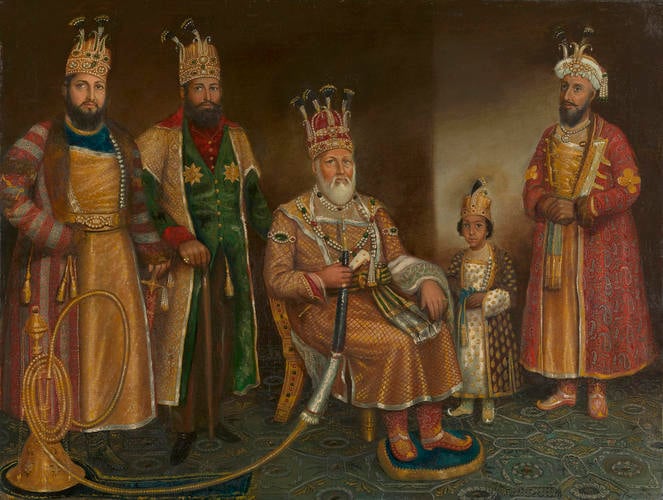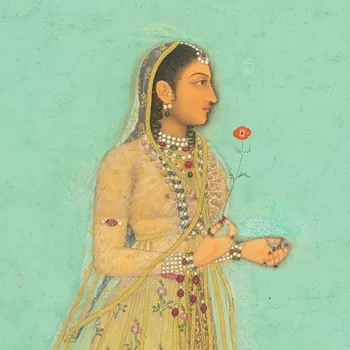Akbar Shah II and his sons c. 1830
Oil on canvas | 60.9 x 80.8 cm (support, canvas/panel/stretcher external) | RCIN 406533
-
This is the only known European-style portrait on canvas of Mughal Emperor Akbar Shah II (r. 1806–37). Aged around 70, he sits on a European-style chair grasping the pipe of a large hookah as he gazes outwards from the canvas. To his left and right are three of his sons, including Mirza Abu Zafar (far right) later Emperor Bahadur Shah Zafar (1775-1862).
Akbar Shah II sent this painting with a letter to George IV but the king had died before it arrived. On 5 July 1830, the Morning Post reported that Viscount Combermere (the outgoing Commander-in-Chief of the British Army in India) had received an audience with William IV 'at which his lordship presented him with a painting from the King of Delhi, representing his sons and grandson, in full costume'.
The painting is likely the work of a Mughal painter who adopted European oil techniques. The fine textile details, impasto effect employed for the jewellery, and the Arabic inscription on Zafar's robe all suggest a local Delhi artist. Later portraits of Bahadur Shah Zafar and his sons by the Delhi painter Ghulam Ali Khan relate to this painting in their composition.
Although we do not know the Emperor's thoughts on this portrait, an account of early 1836 records his disdain for the European convention of depicting shadows under the sitter's nose. Having inspected an oil portrait of himself by the Delhi artist Rajah Jivan Ram, a British onlooker noted that:
the emperor requested him to remove the great blotch from under the nose. ‘May it please your majesty, it is impossible to draw any person without a shadow; and I hope many millions will continue to repose under that of your majesty.’ ‘True Rajah,’ said his majesty, ‘men must have shadows; but there is surely no necessity for placing them immediately under their noses! The ladies will not allow mine to be put there; they say it looks as though I have been taking snuff all my life; and it certainly has a most filthy appearance, besides, it is all awry, as I told you when you began upon it!’ The rajah was obliged to remove from under the imperial and certainly very noble nose, the shadow which he had thought worth all the rest of the picture.
Text adapted from Eastern Encounters: Four Centuries of Paintings and Manuscripts from the Indian Subcontinent, London, 2018Provenance
First recorded in the Round Tower Room no 661 at Windsor Castle in 1879
-
Creator(s)
(artist) -
Medium and techniques
Oil on canvas
Measurements
60.9 x 80.8 cm (support, canvas/panel/stretcher external)
83.1 x 103.0 x 7.9 cm (frame, external)
Category
Object type(s)
Other number(s)
OM add-Anon










